Strategi trading untuk mendukung pengambilan keputusan Anda
Temukan teknik praktis untuk membantu Anda merencanakan, menganalisis, dan meningkatkan trading Anda.


Most traders understand EA portfolio balance through the lens of traditional risk management — controlling position sizes, diversifying currency pairs, or limiting exposure per trade.
But in automated trading, balance is about deliberately constructing a portfolio where different strategies complement each other, measuring their collective performance, and actively managing the mix based on those measurements.
The goal is to create a “book” of EAs that can help diversify performance over time, even when individual strategies hit rough patches.
A diversified mix of EAs across timeframes and assets can, in some cases, reduce reliance on any single strategy. This approach reduces dependency on any single EA’s performance, smooths your overall equity curve, and builds resilience across changing market conditions.
It’s about running the right mix, identifying gaps in your coverage, and viewing your automated trading operation as an integrated whole rather than a collection of independent systems.
Basic Evaluation Metrics – Your Start Point
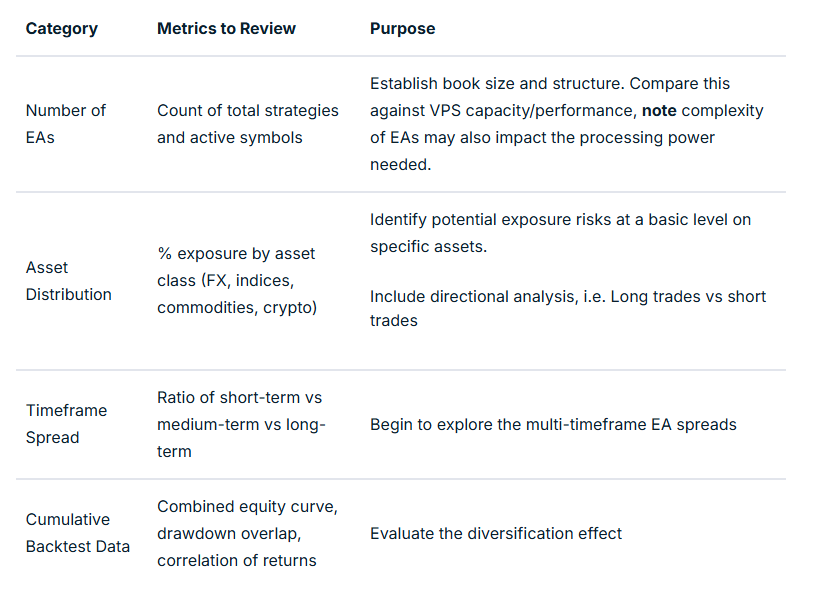
Temporal (timeframe) Balancing
When combined, a timeframe balance (even on the same model and instrument) can help flatten equity swings.
For example, a losing phase in a fast-acting M15 EA can often coincide with a profitable run in an H4 trend model.
Combining this with some market regime and sessional analysis can be beneficial.
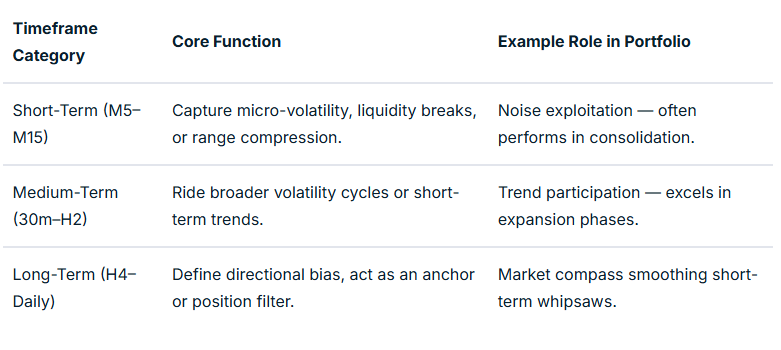
Asset Balance: Managing Systemic Correlation Risk
Running five different EAs on USDJPY might feel diversified if each uses different entry logic, even though they share the same systemic market driver.
But in an EA context, correlation measurement is not necessarily between prices, but between EA returns (equity changes) relating to specific strategies in specific market conditions.
Two EAs on the same symbol might use completely different logic and thus have near-zero correlation.
Conversely, two EAs on a different symbol may feel as though they should offer some balance, but if highly correlated in specific market conditions may not achieve your balancing aim.
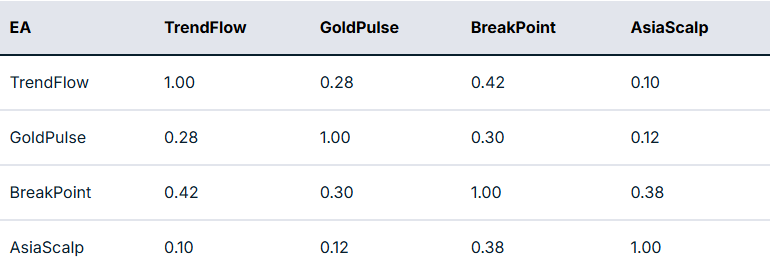
In practical terms, the next step is to take this measurement and map it to potential actionable interventions.
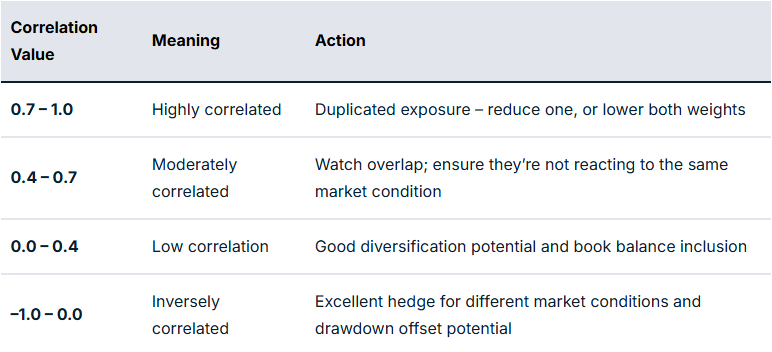
For example, if you have a EURUSD Trend EA and a GBPUSD Breakout EA with a correlation of 0.85, they are behaving like twins in performance related to specific market circumstances. And so you may want to limit exposure to some degree if you are finding that there are many relationships like this.
However, if your gold mean reversion EA correlates 0.25 compared to the rest of your book, this may offer some balance through reducing portfolio drawdown overlap.
Directional and Sentiment Balance
Markets are commonly described as risk-on or risk-off. This bias at any particular time is very likely to impact EA performance, dependent on how well balanced you are to deal with each scenario.
You may have heard the old market cliché of “up the staircase and down the elevator shaft” to describe how prices may move in alternative directions. It does appear that optimisation for each direction, rather than EAs that trade long and short, may offer better outcomes as two separate EAs rather than one catch-all.
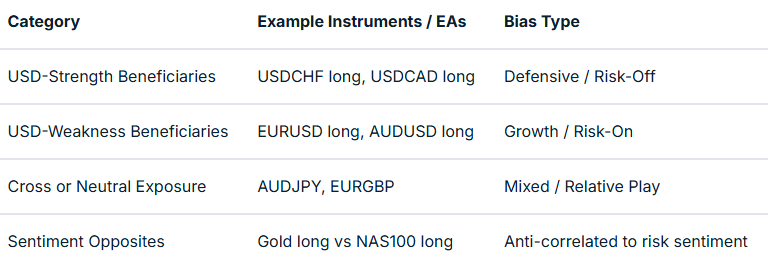
Market Regime and Volatility Balance
Trend and volatility states can have a profound impact on price action, whether as part of a discretionary or EA trading system. Much of this has a direct relationship to time of day, including the nature of individual sessions.
We have a market regime filter that incorporates trend and volatility factors in many EAs to account for this. This can be mapped and tested on a backtest and in a live environment to give evidence of strategy suitability for specific market conditions.
For example, mean reversion strategies may work well in the Asian session but less so in strongly trending markets and the higher volatility of the early part of the US session.
As part of balancing, you are asking questions as to whether you actually have EA strategies suited to different market regimes in place, or are you using these together to optimise book performance?
The table below summarises such an approach of regime vs market mapping:
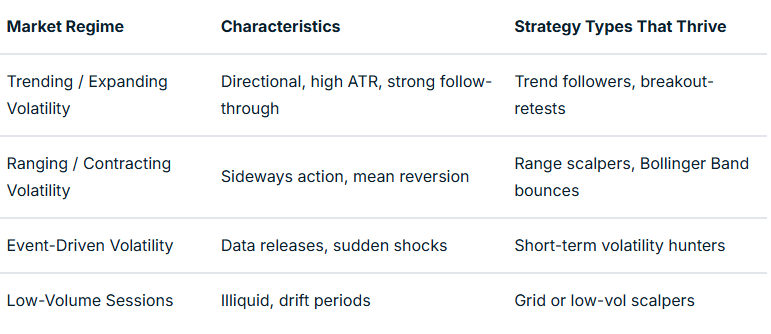
Multi-Level Analysis: From Composition to Interaction
Once your book is structured, the challenge is to turn it into something workable. An additional layer of refinement that turns theory and measurement into something meaningful in action is where any difference will be made.
This “closing the circle” is based on evidence and a true understanding of how your EAs are behaving together. It is the step that takes you to the point where automation can begin to move to the next level.
Mapping relationships with robust and detailed performance evaluation will take time to provide evidence that these are actually making a difference in meeting balancing aims.
To really excel, you should have systems in place that allow ongoing evaluation of the approaches you are using and advise of refinements that may improve things over time.
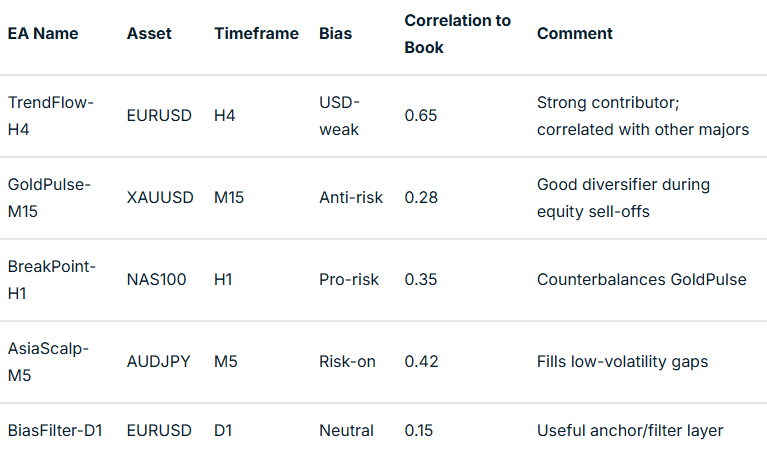
What Next? – Implementing Balance in Practice
Theory must ultimately translate into an executable EA book. A plan of action with landmarks to show progress and maintain motivation is crucial in this approach.
Defining classification tags, setting risk weights, and building monitoring dashboards are all worth consideration.
Advanced EA traders could also consider a supervisory ‘Sentinel’ EA, or ‘mothership’ approach, to enable or disable EAs dynamically based on underlying market metrics and external information integrated into EA coding decision-making.
Final Thoughts
A balanced EA portfolio is not generated by accident; it is well-thought-out, evidence-based and a continuously developing architecture. It is designed to offer improved risk management across your EA portfolio and improved trading outcomes.
Your process begins with mapping your existing strategies by number, asset, and timeframe, then expands into analysing correlations, directional bias, and volatility regimes.
When you reach the stage where one EA’s drawdown is another’s opportunity, you are no longer simply trading models but managing a system of EA systems. To finish, ask yourself the question, “Could this approach contribute to improved outcomes over time?”. If your answer is “yes,” then your mission is clear.
If you are interested in learning more about adding EAs to your trading toolbox, join the new GO EA Programme (coming soon) by contacting [email protected].
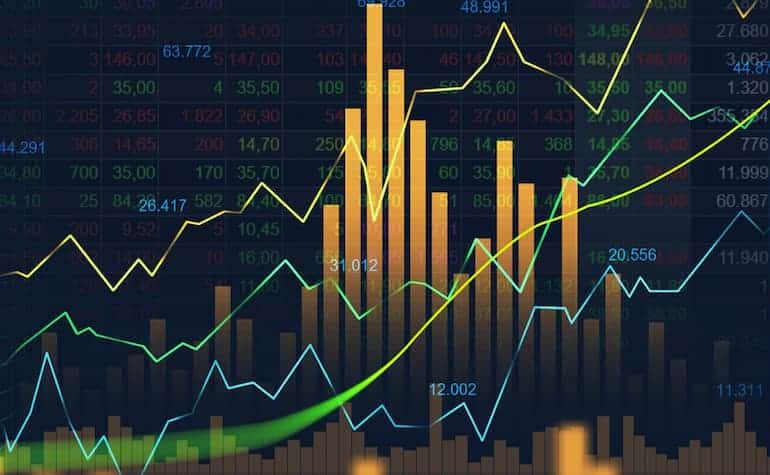

For new traders, it can be difficult to know which indicators to use, the saturation of various moving averages, RSI’s, MACD’s and more can be overwhelming and counterproductive. However, utilising relative volume, as an indicator is one of the most important sources of information for technical traders. What is Volume?
Volume is quite simply, the volume of the asset traded over a specified time. This volume is usually shown by bars, generally located at the bottom of a price chart. Each bar represents one unit of the corresponding time period’s volume traded.
It also shows whether the period ended in the green or red. Volume tends to be reflective of the interest in the asset and is therefore a valuable tool. Why Relative volume?
Now that there is a clear definition of what volume is, understanding relative volume is straight forward. It has been established that volume is indicative of the amount of the asset traded for that time. Essentially, most assets will have a consistent or average volume that gets traded over a specified time, whether it be an hour, day, or a week.
Generally, the longer the time frame, the more weight a trader should give to that average. A large spike in the volume relative to the average is what a trader should be looking for. The volume bars are the best indicators of this.
Larger volumes can indicate larger positions being taken and increasing interest. Therefore, increases in relative buying volume can be a leading indicator for a move to the upside. On the contrary, a large red volume bar can be a leading indicator that price drop is about to occur as a large position is exiting.
A rule that many retail traders like to use is to follow the “big money” or institutions. Big institutions cannot just enter or exit their positions quickly like retail traders. Therefore, these institutions leave a trail of their entries and exits, that experienced traders can capitalise on and follow.
Understanding how shifts in volume can indicate, potential break outs, break downs and reversals takes time and practice but is a valuable tool that any trader should utilise to improve their entries and exits. A few examples of volume indicating changes in price action. Apple's sharp increase in selling volume indicated the ‘top’ and has not reached those high since.
Similarly, the chart for Brent Oil showed a similar pattern whereby it could not breakthrough a long-term resistance level and combined with a large volume of selling signaled that the price had peaked. The price for Stanmore Resources saw a big push after the influx of new volume and has its price increase since the first candle. This may indicate that institutions have added the company to its holdings or that significant buying interest has returned.
Further way to optimise using relative volume Anticipating Relative volume shifts by understanding that they tend to follow on from big news events, such as unexpected results or broader macro factors. Combining big volume shifts with a break of a key support or resistance level Combining with other technical indicators. Use a collection of volume bars vs just one to see the shift in relative volume


What is a deflationary Cryptocurrency? A Deflationary Cryptocurrency is one that burns, (mints) its supply. This process lessens the number of coins or tokens on the market over a specific period (generally a year), which reduces supply and increases the price.
In general terms, ensuring that there isn’t an oversupply of a currency can be an important monetary tool to reducing inflation. Evidence of quantitative easing and what can happen when there is an oversupply can be seen by the record high inflation seen around the world. The two largest cryptocurrencies, Bitcoin and Ethereum, are both tipped to become deflationary in the future but for varying reasons Is Bitcoin deflationary?
Bitcoin has a fixed, maximum supply of 21,000,000 BTC that will be fully mined in the year 2140. The current supply of BTC is 19,008,012.00 and 20% of this supply has been lost due to forgotten passwords and forgotten keys. It’s projected that Bitcoin may officially become deflationary once its full supply has been created, as the circulating supply will continue to reduce due to holders’ unintentional losses.
Is Ethereum deflationary? Unlike, Bitcoin, Ethereum does not have a maximum supply. Rather, it has an annual supply cap at 18 million ETH.
For Ethereum to become deflationary, 2 ETH would need to be burned per block; this is because this amount is minted for each block that is mined. As per the historical data, the ETH net issuance will dive lower creating a rally in the ETH price as the circulating supply will be less. A common way to achieve deflation is by burning tokens.
Ethereum does this by minting tokens that are staked or when NFTs are minted. A point worth noting is that cryptocurrencies with a finite supply are deflationary by default. When investors buy and hold the coin, the supply reduces.
Ethereum has temporarily turned deflationary in the last few days. An unknown project by the name of XEN has assisted in the burning of ETH. What is XEN?
XEN is a project created by the “Fair Crypto Foundation,” backed by Jack Levin, one of the first employees at Google working on cloud infrastructure. The ethos aims to empower the individual with a token that starts with a zero supply and has no pre-mint, CEX listings, admin keys, or immutable contracts. XEN, which launched on Oct. 8, can be claimed, minted, or staked and is based on the first principles of cryptocurrency: self-custody, transparency, trust through consensus, and permissionless value exchange without counterparty risk.
XEN can only be traded on Uniswap, where there is very little liquidity. Time will tell if the latest hot cake in crypto turns into just another swindle. Key Takeaways ETH has turned deflationary over the past 24 hours.
High gas consumption to mint tokens for the new project XEN Crypto is the primary cause of the ETH supply drop. ETH's supply has dropped on several occasions since Ethereum completed "the Merge" in September. Are you keen to venture into trading Cryptocurrency pairs, FX, stocks or commodities?
If so, you can do so by opening an MetaTrader trading CFD account with GO Markets here or call our Melbourne based office on 03 8566 7680 to discuss your trading goals with our account managers to get started. Sources: https://au.finance.yahoo.com/, https://xcoins.com/, https://coingape.com/, https://cryptopotato.com/, https://cryptoslate.com/


Long and Short trading and investing strategies are often seen as advanced strategies only used for large hedge funds and large banks. However, retail traders can learn valuable lessons and ideas from this type of trading strategy that is usually reserved for institutional players. What is a long-short strategy?
A long-short strategy as described by its name involves holding a basket of both long and short positions of assets all a part of a portfolio or a singular trading strategy. These assets tend to be equities securities or derivatives but can also be other asset classes such as commodities and FOREX. The idea behind the strategy is that due to the negative correlation between the shorts and long positions they cancel out much of the market volatility whilst at the same time profiting up movements in price in either direction.
Steps to develop a Long Short strategy Establish which assets classes you wish to trade This step involves generating ideas for which asset classes you whish to trade. This may include FOREX, Commodities, Indices, or equities. For many traders, a combination of assets may produce an effective strategy.
For example, someone may choose to allocate 60% of the portfolio to equities, 20% to FOREX and 20% to commodities or 100% to equities. Determine how many assets to hold with in strategy. The aim of this section is to ensure that there are enough assets to be, diversified enough that a significant move in one direction will not blow the strategy out and to ensure.
The strategy requires that enough assets are held to minimise the volatility. If too few assets are used, then the returns may not be consistent enough and prone to large gains and losses. A standard range may include 20 assets with the breakdown of long and short varying from strategy to strategy.
Apportion the % of assets that will be held long and those that will be held short? This step involves an element of discretion and is where the individual trader can utilise their own experiences and edge to enhance the strategy. For instance, some traders may choose to create a 50/50 split strategy.
This means that exactly half the assets will be long, and half will be short. More specifically this split may occur via value weighting, number of assets or by price per share. Alternatively other strategies may involve having a lower proportion of short assets held, such as 20% Short and 80% long.
These types of strategies may work better when in a trending market because the strategy can still make money on assets that are falling in value whilst also taking advantage of the strong overall market trend. Choosing the individual assets to be held This is perhaps the most important step of the process. Choosing assets to hold can be a difficult task and may require both technical and fundamental analysis to find top performing assets to hold long and poor performing stocks to hold short.
The craft of the long, short strategy is performed at this stage as a trader needs to find high performing or low performing assets. An example of a 50/50 Long Short Portfolio construction is shown below. (NOTE this is a fictional Long Short portfolio and is not a real strategy or portfolio) Positives of a Long Short Strategy A long-short strategy may be able to avoid volatile returns and the effect of a choppy market because the short positions can reduce negative returns if the market is falling, and long positions can take advantage of the market is lifting. if a trader can effectively allocate their Longs and shorts, profit can be effectively achieved in most market conditions. Allows a trader to utilise their ‘edge’ for a wider array of assets.
Disadvantages This approach requires active portfolio management. As positions are constantly changing and weightings for different assets change, adjustments may need to be made to ensure that the strategy continues to balance. A Long Short strategy also generally requires a longer time frame then other scalping strategies or intraday strategies.
Having short positions means that the holder of the short is at risk of short squeezes. A short squeeze is something that anyone wishing to short should be aware of. It occurs when to many short positions attempt to close their positions at once.
This can cause a spike in the price and may force bigger positions to close, further driving up the price. Ultimately, a Long Short strategy for trading and investing can be a way to achieve more stability in volatile market conditions and provide a way to capitalise on market movements in both directions. Even just understanding how a Long-Short strategy works can provide traders and investors with enhanced understanding of how market forces impact on trading and potentially provide new strategies.


Many trading strategies utilise technical analysis to predict price patterns and for entries and exits. These strategies revolve often begin with the idea of the price having identifiable support, resistance and trendline market structures which indicate where various buying and selling points can be placed for a trade. These support and resistance indicate far more then just the price at a moment in time.
Rather they reflect the psychology of the market at a given point in time. However, when trading it is important to remember that the market is not just made of one type of trader. The market is made up of day traders, swing traders, scalpers, funds, hedge funds, retirement funds, Investment banks and all in between.
Each of these participants has their own time frame for a trade/investment. This element is the key as to why trader can utilise multiple time frame analysis. The theory it that the more market participant who view the respective level as a support or resistance, the more likely it will act in that way.
For example Assume that the price of stock A is sitting on a 5-minute support at $100. Looking purely at this 5-minute chart a trader may look to buy on this support level. However, after looking at the 30-minute chart, the chart shows that the price is not actually a support but rather just a random price point and therefor no trade is entered.
Alternatively, the 30-price chart supports the original price as a support and therefore may support the price point being a support point. How to implement multiple analysis into your trading. Determine your standard trading timeframe.
This step should be a relatively simple step if you have a clear edge. For some traders it can be 5 minutes, 15 minutes, 1 hour, one day or even one week. Work back usually by a factor a factor of 4/5 or by a logical time frame adjustment Prior to your first drawing of support resistance and trendline it is important that you adjust the timeframe of your price chart by a factor of 4/5 or a by logical adjustment such as an hour – to a day or day to week.
Example 5min – 30 min 1 hour – 4 hours 1 hour – day 1 day – 1 week 1 week – 1 month Add in Support and Resistance Lines on longer term time frames The analysis can now start, and the key is to draw the most obvious and consistent support and resistance time frames. This step also serves an important step in helping determine if the price is trending or is ranging. Revert to trading time frame and redo the same process highlighting convergences The next step is to revert to the desired trading time frame and conduct the same process.
This time if there is a Support/resistance line that is already made and acts as one on the shorter timeframe, highlight it or tag it. Looking at the example below for US car making company Tesla, the process is shown on the chart below. Firstly, with the weekly chart, support and resistance points were plotted with the black lines.
The below the daily chart shows that the support point at $265.25 acts as support for both timeframes. This indicates that price may act with more strength as a support zone. Similarly, if the level breaks it may indicate a more powerful move because more market participant will likely be involved.
In the other example for the EURUSD the same process has been done and shows that the price at 0.9600 is also doubling as a support on the daily and weekly charts. The use of multiple time frame analysis can optimise trading systems by reducing risks of fake breakouts and improving entry and exit accuracy.


Maturity, Yields, Par Values and Coupon payments. These are words that everyone has heard of but not many have a good understanding of what they mean. In this article all these complicated terms will be explained.
Please note that while this information is most relevant for physical bonds, it is still important to understand when dealing with CFD’s as they play an important role in how bond CFD’s are valued. What is a Bond? A bond is an instrument that is used by companies and governments and other entities to raise money through the issuing of debt.
There are different typed of bonds however, the simplest bonds are contracts in which an issuer (Company/Government) receives a payment from the purchaser or bond holder in exchange for the rights to interest plus the principal amount. For example, a government may issue a 10-year bond for $1000 in which they agree to pay 1% interest per annum which will equate to $10 per year. In addition, they will pay back the principal amount once the bond matures.
Key Terms Issuer – The entity that sells the bond initially and must make payments. Holder – The entity who is possession of the bond. Principal – The amount of debt that the government/company has taken that will be paid at maturity.
Par Value – The nominal value of the bond or the price when it was issued. Coupon Payment - The interest payment that is paid to the bond holder. Yield –The coupon payment divided by the Bonds face value.
Maturity – The date when the principal amount of the bond will be paid back. Bond Ratings Generally, Bonds are rated according by agencies, based on how safe the underlying assets are. For instance, government bonds tend to be rated the highest as they are guaranteed by the government, and governments are highly unlikely to default.
In a practical sense, the US government is such a reliable issuer that it should never default on the repayments. This makes Bond’s a great asset to act as a hedge against unsystematic risk. On the other hand, corporate bonds may be given lower ratings depending on their credit risks.
Inverse Relationship between Bond Price and Yield The price and yields for bonds are inversely related. This is important to note as bonds are often charted against their yield and not price which is how derivatives are often charted. Therefore, a trader should be aware of the inverse relationship between price and yield.
This occurs because as the price of a bond changes up or down the interest rate must adjust to ensure that the coupon payment is the same. Assume Bond A is issued at $1000 dollars and 10% interest rate to pay a $100 coupon. 1 Year later that same bond is now priced at $900, however the bond must still pay out a $100 coupon. However, to get a coupon payment of $100, the interest rate must increase.
The formula below shows this: $900 x Interest Rate = 100. Simple Algebra shows that the interest rate = 11.1% Understanding this relationship will make eliminate one of the more confusing elements of trading bonds. Catalysts for Bond Prices The general factors that influence a bond’s price are related to the interest rates and the broader economy.
For instance, if the market interest rate 2% and the bond’s coupon rate is 1%, then the bond will trade at a lower price and vice versa. Subsequently, bonds can be a handy way of tracking the sentiment as they often reflect the feeling in the market. Economic events can impact on the performance of bonds.
When the economy is growing and equities are doing well, bonds tend to perform worse as the return is limited. However, during times of volatility and poor stock market performance, the bond market tends to perform better as the market looks for safety in the guaranteed returns from bonds. Inflationary pressure and low or high interest rates can influence the direction of the way in which bonds are traded.
Generally, in a strong economic market, bonds with longer maturities tend to have higher yields than those in shorter maturity. This is generally due to the thought that the time that is further in the future will has more uncertainty than that in the near-term future. The general exception to this is when the market expects a recession soon.
This causes what is known as an inverted yield curve, in which the shorter-term bond is yielding a higher interest then the long-term bonds. You can trade CFD on the 10 Year US treasury note, 5 Year US treasury Note, UK Gilt, Euro Bund and the JGB Japan Futures on Go Markets Metatrader 5 platform


In my previous article we discussed, what is an EA and their benefits. To read up on their disadvantages please follow the link to an article written by my colleague Daniel Vary here. Today we are going to discuss how you would use a VPS to enhance the use of an EA, especially if you are running various EAs simultaneously.
What is a VPS? A virtual private server (VPS) is a virtual program sold as a service by an Internet hosting service. The virtual dedicated server (VDS) also has a similar meaning.
A virtual private server runs its own copy of an operating system (OS), and customers may have superuser-level access to that operating system instance, so they can install almost any software that runs on that OS. For many purposes it is functionally equivalent to a dedicated physical server and, being software-defined, can be created and configured much more easily. Depending on the resources that you choose, the location of the server, the virtualization technology, and the quality of your service, the price of your VPS will change.
GO Markets provides a VPS to all its clients, it’s a free trading tool we make available which would otherwise come with a monthly fee. Why would traders use a VPS and what advantages do they offer? As a trader who is looking to incorporate an Expert Advisor in their trading strategy, they may well need the use of a VPS, this helps to facilitate a smooth working condition for one or several EAs running simultaneously and to run as effectively as possible.
An Expert Advisor is a tool that is programmed to work 24/7, it is imperative that the running of your trading system and the vessel which it operates in i.e. computer or laptop is not disrupted, go offline or lose power, otherwise you will find that your EA won’t be able to operate, open, close trades or do whatever you intend to do with it. A simple advantage to think about, is purely that a VPS enhances the EAs capabilities and with it, it may improve your trading goals. A VPS facilitates a smooth and quick link to a reliable server, that means it keeps the connection alive for as long as possible to allow the EA to do its job, getting access to a reliable server should be your highest priority, especially given the nature of how fast paced markets like Forex markets can be.
Choosing a VPS provider? There are few important points that you need to look into when choosing the type of VPS you want to acquire. There are some key features to look understand to get a VPS that will fit within your EAs specifications, your trading strategy and style.
We will look at the specific features of the VPS shortly but first you need to consider which Operating System OS you like your VPS to run on, Windows or Linux? Linux is an open-source operating system and is cheaper than windows. The Windows VPS hosting can be preferred if you are developing in.NET or if you have applications that are designed for the Windows platform.
RAM – It stands for random-access memory. It means that your computer RAM is essentially short-term memory where data is stored as the processor needs it. The Ideal RAM for a VPS for this purpose would be 4 GB.
If you are running several EAs, which use up more than the available RAM, then may need to look for a bigger VPS or simply add another VPS on another account. CPU – Central processing unit, is a principal part of any digital computer system, generally composed of the main memory, control unit, and arithmetic-logic unit. They have proved to work smoothly even at peak times depending on the quality and size of the processor.
You need to have 14nm architecture with a multi-core for multitasking but a 6vCPU works in most normal cases. Hard disk HDD – The traditional hard disk storage space will always be bigger and more inexpensive. But a solid-state drive is recommended for a VPS hosting.
They are fast at rebooting; the performance is certainly huge and transfer speeds are more than the traditional disks. The SSDs are resilient during power failures, which makes them a perfect fit for VPS hosting. A faster hard drive is necessary because even if the RAM and CPU are fast you need an equally faster storage drive to service those requests Go Markets VPS As a valuable client of GO Markets, you can get access to a VPS once you have a live account with us.
Simply, by applying for one via your Client Portal. The VPS runs on both MT4 and MT5 systems and allows you to execute trades using EAs, quicker and easier. GO Markets offers free monthly VPS access to clients completing a minimum trade volume of US$1m per calendar month (approx. 5 round turn FX lots).
If this volume is not met, a VPS service fee will be applied per month which will be charged from trading account. Please see below the specifications of our VPS below. Our VPS is a Shared Hosting, managed Cloud based solutions running on Windows 2016.
Sources: Wikipedia, Babypips, GO Markets, operavps.com, www.websitebuilderexpert.com,

